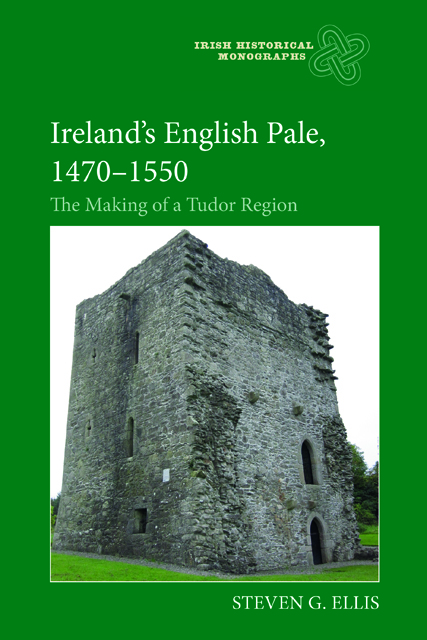Book contents
- Frontmatter
- Contents
- List of Maps
- Preface
- List of Abbreviations
- Introduction: in search of Ireland's English Pale
- 1 The horizons of English rule: retreat and recovery
- 2 The fortifications and identity of a military frontier
- 3 County Dublin and the military frontier
- 4 Strengthening the march in County Kildare
- 5 The English Pale's westward expansion: County Meath
- 6 The English Pale's northern frontier: County Louth
- 7 Restoring the English Pale, 1534-41
- 8 The waning of the English Pale
- Conclusion: an English region in Tudor Ireland
- Bibliography
- Index
- Irish Historical Monographs previous volumes
Introduction: in search of Ireland's English Pale
Published online by Cambridge University Press: 09 January 2024
- Frontmatter
- Contents
- List of Maps
- Preface
- List of Abbreviations
- Introduction: in search of Ireland's English Pale
- 1 The horizons of English rule: retreat and recovery
- 2 The fortifications and identity of a military frontier
- 3 County Dublin and the military frontier
- 4 Strengthening the march in County Kildare
- 5 The English Pale's westward expansion: County Meath
- 6 The English Pale's northern frontier: County Louth
- 7 Restoring the English Pale, 1534-41
- 8 The waning of the English Pale
- Conclusion: an English region in Tudor Ireland
- Bibliography
- Index
- Irish Historical Monographs previous volumes
Summary
The establishment of the English Pale in Ireland is seemingly one of the most familiar – yet enigmatic – developments in Irish history. When was it created? Was it a region or a frontier? What were its boundaries? When I was preparing my doctoral dissertation at Queen’s University, Belfast, in the mid-1970s, I was conscious on my regular research trips to Dublin of crossing a frontier to enter the English Pale. The many surviving tower houses around the Pale and the occasional earthworks of its standing defences still attest to its erstwhile frontier status. South of Newry, the railway negotiated stretches of desolate upland, skirting Slieve Gullion, and passing a tower house near the summit of the line out of Dundalk, before dropping down to the rich arable farming land in County Louth to stop at Dundalk station: we had entered what was once the English Pale. There, a hurried inspection by Irish customs of the train and its passengers served as a reminder that this stretch of railway once again crossed a frontier. These days, however, it is more the Pale’s spatial dimension which enjoys a somewhat attenuated existence in the popular imagination. The Pale denotes the area around Dublin (northwards to Dundalk, inland beyond Mullingar), supposedly marked by a more refined pronunciation of English, more English attitudes, and heightened levels of civility – as contrasted with their countervailing values reflected in the expression ‘beyond the Pale’. A few years ago, the Limerick-born broadcaster, Terry Wogan, echoed these sentiments when he claimed to be a ‘child of the Pale’. ‘I’m an effete urban Irishman’, he added, ‘I was a West Brit from the start.’
My interest in the English Pale was first sparked when I discovered the Kildare rebellion. Here was a Tudor rebellion, centred on Ireland’s Pale region in 1534–5 and led by Henry VIII’s greatest magnate there. Why was this apparently classic provincial protest, against centralizing English government and Henry VIII’s religious policies, entirely ignored in the standard survey of Tudor rebellions? At the time, I had no answers, but I kept the question in mind when beginning a doctoral dissertation on English government in early Tudor Ireland. Some ten years later, a version of my PhD thesis was published.
- Type
- Chapter
- Information
- Ireland's English Pale, 1470-1550The Making of a Tudor Region, pp. 1 - 13Publisher: Boydell & BrewerPrint publication year: 2021



